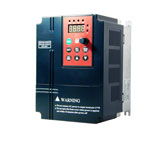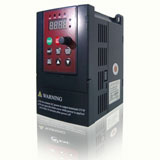Q: Regenerative energy from the motor back to supply
I have a problem in understand the regenerative energy in sample way if there is regenerative energy from the motor to the supply it will increase the voltage and current that come back to supply ? in another word if I measure the AC voltage in the terminal L1 and L2 of the motor in the moment of regenerative energy it will be more than 400V?
Answer:
Are you familiar with phasor diagrams? With an induction motor, there are two components to the motor current, the real (kW) current, and the reactive (kVAR) current. Real power is represented by the X-axis, reactive power by the Y-axis. The reactive power measures how much current it takes to magnetize the motor. At fixed voltage and frequency, this value is pretty much also fixed. The Real component is dependent on load (part is heat loss through wire resistance, the rest goes into making torque). Power factor is the measurement the angle between the apparent power (kVA) and real power (kW).
For the purposes of illustration, assume that the Real component (---> vector) is 4 amps, the reactive component (^ vector) is 3 amps. By Pythagoras' theorem the apparent power - the hypotenuse of the triangle formed by these two vectors (kVA = [kVAR² + kW²]¯²) - is 5 amps at an angle (tan-1 of 3/4) of 36.8° - a power factor of 0.368.
Obviously this is a terrible power factor, but I used a 3-4-5 right triangle for illustration purpose only.
Now, apply your VFD-driven motor to the "load" motor shaft. Accelerate the VFD motor until the load motor is operating at synchronous speed. The closer you get to sync speed, the lower the real power will be. Since the applied voltage doesn't change, the real current must. At synchronous speed there will be no slip in the load motor. The rotor is spinning at the same speed as the rotating field. No lines of flux are being cut, no current is induced in the rotor. The only current that motor will draw is reactive current, correct?
Now spin the VFD motor FASTER than synchronous speed, and what will happen? The motor will provide braking torque (torque in the direction opposing rotation). The load motor current must go negative, correct? Power (kW) will flow OUT of the motor to the utility, no?
An example of this would be a crane hoist lowering a heavy load, or an electric street car rolling downhill. The motor provides braking torque preventing the crane from dropping the load or the street car from running away. Yes, the typical result is that the voltage measured at the motor terminals goes up a tiny bit, but the utility is the 800 lb. gorilla in this room - you're not going to affect the distribution network much. You just became a (very small) power source on that network, rather than a load.
(If I ever do this application again, I'm going to have to hook up a power quality analyzer and actually watch the voltage and current phasors.)
Answer:
Are you familiar with phasor diagrams? With an induction motor, there are two components to the motor current, the real (kW) current, and the reactive (kVAR) current. Real power is represented by the X-axis, reactive power by the Y-axis. The reactive power measures how much current it takes to magnetize the motor. At fixed voltage and frequency, this value is pretty much also fixed. The Real component is dependent on load (part is heat loss through wire resistance, the rest goes into making torque). Power factor is the measurement the angle between the apparent power (kVA) and real power (kW).
For the purposes of illustration, assume that the Real component (---> vector) is 4 amps, the reactive component (^ vector) is 3 amps. By Pythagoras' theorem the apparent power - the hypotenuse of the triangle formed by these two vectors (kVA = [kVAR² + kW²]¯²) - is 5 amps at an angle (tan-1 of 3/4) of 36.8° - a power factor of 0.368.
Obviously this is a terrible power factor, but I used a 3-4-5 right triangle for illustration purpose only.
Now, apply your VFD-driven motor to the "load" motor shaft. Accelerate the VFD motor until the load motor is operating at synchronous speed. The closer you get to sync speed, the lower the real power will be. Since the applied voltage doesn't change, the real current must. At synchronous speed there will be no slip in the load motor. The rotor is spinning at the same speed as the rotating field. No lines of flux are being cut, no current is induced in the rotor. The only current that motor will draw is reactive current, correct?
Now spin the VFD motor FASTER than synchronous speed, and what will happen? The motor will provide braking torque (torque in the direction opposing rotation). The load motor current must go negative, correct? Power (kW) will flow OUT of the motor to the utility, no?
An example of this would be a crane hoist lowering a heavy load, or an electric street car rolling downhill. The motor provides braking torque preventing the crane from dropping the load or the street car from running away. Yes, the typical result is that the voltage measured at the motor terminals goes up a tiny bit, but the utility is the 800 lb. gorilla in this room - you're not going to affect the distribution network much. You just became a (very small) power source on that network, rather than a load.
(If I ever do this application again, I'm going to have to hook up a power quality analyzer and actually watch the voltage and current phasors.)



